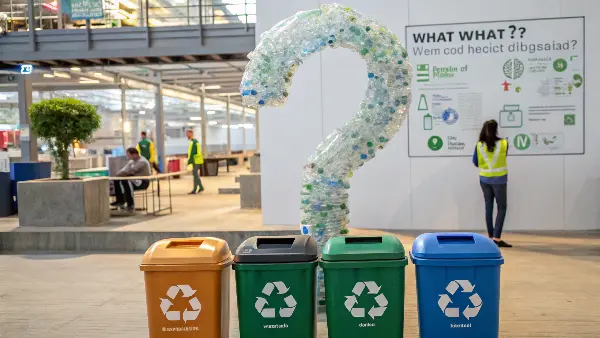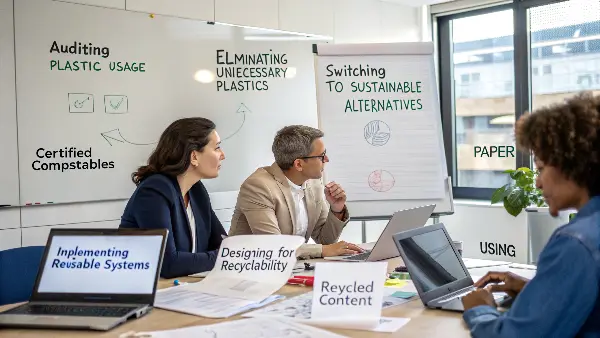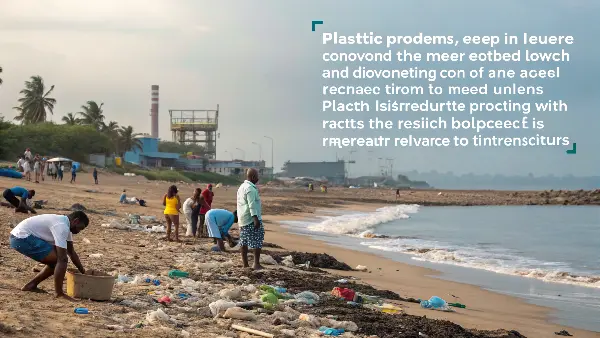Plastic seems convenient, but its environmental toll is staggering and often hidden. Are you aware of the true cost, and is your business taking steps towards a better approach?
The hidden costs include fossil fuel depletion for production, greenhouse gas emissions during manufacturing, persistent pollution of land and oceans, harm to wildlife through ingestion and entanglement, and the long-term burden on waste management systems.
As businesses increasingly focus on sustainability, understanding the full impact of materials like plastic is crucial. For packaging specialists like Jacky in Canada, finding alternatives isn’t just about image; it’s about mitigating real environmental damage. At Ecosourcecn, we help businesses transition away from problematic plastics. Let’s break down the costs and explore how your business can improve.
What are the environmental costs of plastic?
We see the price tag on a plastic item, but what’s the unseen environmental bill? Ignoring these lifecycle costs gives a false picture of plastic’s affordability and impact on our planet.
Plastic’s environmental costs span its entire life: intensive resource extraction (oil/gas), energy-hungry production emitting GHGs, widespread pollution (especially oceans), microplastic contamination, direct harm to wildlife, and centuries-long persistence in landfills or nature.
!
The environmental burden of plastic starts long before it becomes waste. Let’s trace its journey:
Plastic’s Lifecycle Impacts
- Raw Material Extraction: Most plastics are derived from fossil fuels (oil and natural gas). Extracting these resources requires significant energy, can damage landscapes, and carries risks of spills and pollution. Water usage is also considerable.
- Manufacturing: Converting raw fossil fuels into plastic resins (polymerization) and then into products is highly energy-intensive, releasing substantial greenhouse gases (like CO2 and methane) that contribute to climate change. Chemical additives used for color, flexibility, or flame resistance can also pose environmental risks.
- Usage: While the direct environmental impact during use might seem minimal, the single-use nature of much plastic packaging means this phase is short, rapidly leading to disposal.
- End-of-Life: This is where the most visible problems occur.
- Landfill: Plastics take hundreds or thousands of years to degrade, consuming valuable landfill space. They can leach harmful chemicals into the soil and groundwater.
- Incineration: While it can generate energy, burning plastic releases greenhouse gases and potentially toxic pollutants (like dioxins and furans) if not done with advanced pollution controls.
- Environmental Leakage: A significant portion escapes waste management systems, polluting land, rivers, and ultimately oceans. It breaks down into microplastics, entering food chains and ecosystems. Wildlife suffers through entanglement and ingestion.
Thinking about this lifecycle reminds me of visiting manufacturing sites early in my career – seeing the massive energy inputs and chemical processes really brings home the upstream costs, long before a plastic fork ever reaches a consumer.How can we make plastic better for the environment?
Plastic offers benefits like durability and low weight, so can we improve it? Simply accepting its current environmental profile isn’t sustainable, pushing us to innovate and rethink its role.
Strategies include designing products for easier recycling, significantly boosting collection and recycling rates, increasing the use of recycled plastic content, developing functional bio-based alternatives, and advancing chemical recycling technologies.

While reducing plastic use is often the best strategy, improving the plastics we do use is also vital. Here’s how we can approach it:
Strategies for Greener Plastics
- Design for Recyclability: This means avoiding problematic materials or combinations. Using mono-materials (like PET or HDPE) instead of complex multi-layer films, avoiding dark pigments that hinder sorting, using washable adhesives for labels, and simplifying product designs make mechanical recycling more feasible and efficient. I recall the frustration of dealing with packaging that looked recyclable but wasn’t due to a hidden barrier layer – a classic design failure.
- Increase Recycling Rates: This requires investment in collection infrastructure (like curbside programs), sorting facilities (MRFs) equipped with modern technology (e.g., optical sorters), and consumer education to reduce contamination. Extended Producer Responsibility (EPR) schemes, where producers fund collection and recycling, are proving effective in some regions.
- Use Recycled Content: Creating demand for recycled plastics (like rPET, rHDPE) by incorporating them into new products is crucial for closing the loop. Challenges include maintaining quality, ensuring food-contact safety, and securing consistent supply, but it’s essential for a circular economy.
- Develop Sustainable Bio-based Plastics: Using renewable feedstocks like corn, sugarcane, or algae instead of fossil fuels can reduce carbon footprint if sourced sustainably. However, "bio-based" doesn’t automatically mean "biodegradable." Some bio-plastics are chemically identical to fossil plastics (e.g., bio-PET) and just as persistent. Compostable bio-plastics (like PLA) need specific disposal routes.
- Advance Chemical Recycling: Technologies like pyrolysis or gasification break plastics down into basic chemical components (monomers or feedstocks) to create new plastics or fuels. This could handle mixed or contaminated streams unsuitable for mechanical recycling, but challenges remain regarding energy efficiency, scalability, and environmental impact.
How can businesses reduce plastic pollution?
Your business uses plastic, contributing to the problem, but also holding the power for change. Ignoring this responsibility risks brand reputation and misses opportunities for sustainable innovation appreciated by customers.
Businesses can significantly cut plastic pollution by auditing their usage, eliminating unnecessary plastics, switching to sustainable alternatives (e.g., certified compostables, paper), implementing reusable systems, designing for recyclability, and using recycled content.

Businesses like Jacky’s play a critical role in tackling plastic pollution. It’s not just about compliance; it’s about proactive leadership. Here are key actions companies can take:
Business Strategies for Plastic Reduction
- Audit and Reduce: Conduct a thorough review of where plastic is used across operations and supply chains. Identify and eliminate unnecessary or problematic plastics first – think redundant packaging layers, single-use items where durable alternatives exist, or switching from plastic to digital documentation. Ask: is this plastic truly essential?
- Switch to Sustainable Alternatives: Where plastic functions can be replaced, opt for more eco-friendly materials.
- Compostables: For items like food service ware, certified compostable materials (PLA, CPLA, bagasse) can be excellent if appropriate composting infrastructure exists for customers (linking back to Mistake 4!). Working with suppliers like Ecosourcecn ensures you get genuinely certified products.
- Paper/Fiber: FSC-certified paper and molded pulp offer renewable options for many packaging needs. Ensure any coatings (like PLA linings for cups) are compatible with end-of-life streams.
- Other Materials: Glass and metal offer durability and high recyclability for certain applications.
- Implement Reuse Models: Explore reusable packaging systems, especially in B2B supply chains or closed-loop consumer models (e.g., refillable containers, reusable transport packaging). This fundamentally shifts away from single-use.
- Choose Recycled Content: When virgin plastic is unavoidable, specify recycled content (e.g., rPET, rHDPE) to support the recycling market and reduce reliance on fossil fuels.
- Design for End-of-Life: If using plastic, design for recyclability within the systems available in your target markets. Communicate disposal instructions clearly to consumers. I always advise clients like Jacky to consider the entire lifecycle from the start.
How can we solve the environmental problems caused by plastics?
The sheer scale of plastic pollution feels overwhelming, leaving many wondering if solutions are possible. Relying on isolated actions won’t work; a coordinated, multi-level strategy is our only way forward.
Solving the plastic crisis requires a global effort combining reduced consumption, innovative product/material design, massive scaling of recycling and composting infrastructure, policies like EPR, international cooperation, and fundamental shifts in business models and consumer behaviour.

There’s no single magic bullet for the plastic problem. It demands a comprehensive approach involving governments, industry, scientists, and individuals. Key elements include:
A Multi-pronged Solution Strategy
- Reduce Overall Consumption: The most effective approach is to use less plastic in the first place. This involves questioning our reliance on single-use items and promoting mindful consumption.
- Policy and Regulation: Governments play a crucial role through bans on harmful single-use plastics, taxes on virgin materials, mandatory recycled content targets, and robust EPR schemes that make producers responsible for packaging afterlife. International agreements, like the ongoing UN treaty negotiations, are vital for global coordination.
- Infrastructure Investment: Significantly scaling up collection, sorting, and processing capacity for both recycling and composting worldwide is essential. This includes supporting infrastructure in developing nations where leakage rates are often highest.
- Innovation in Materials and Systems: Continued research into truly sustainable alternative materials (that are biodegradable/compostable in diverse environments or easily recyclable) and new delivery models (reuse, refill) is needed. This includes improving recycling technologies.
- Corporate Leadership: Businesses must go beyond compliance, setting ambitious reduction targets, investing in sustainable alternatives, collaborating within their sectors, and being transparent about their plastic footprint. Companies like Jacky’s, actively seeking better solutions, drive market change.
- Public Awareness and Behaviour Change: Educating citizens about the impacts of plastic, proper waste disposal, and the value of demanding sustainable options from businesses empowers individual action and creates market pressure. We all have a role to play. It’s a complex challenge, but seeing the progress in areas like compostable materials at Ecosourcecn gives me hope that we can innovate our way to better solutions.
Conclusion
Plastic’s hidden environmental costs are immense, impacting resources, climate, and ecosystems. Businesses can drive change by reducing use, choosing sustainable alternatives like compostables, improving design, and supporting systemic solutions for waste management.


